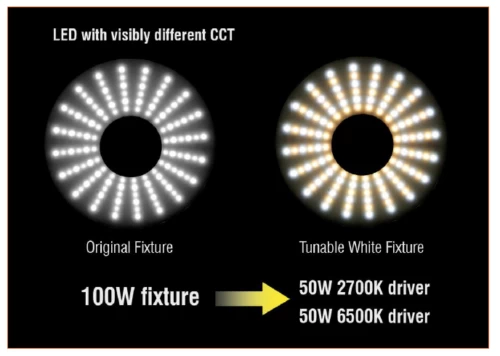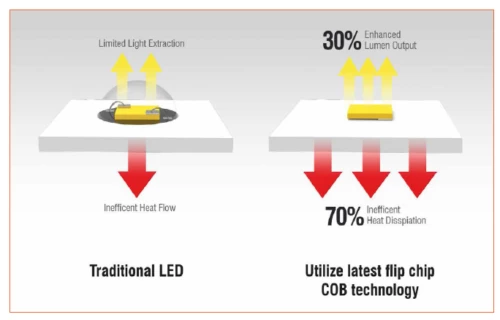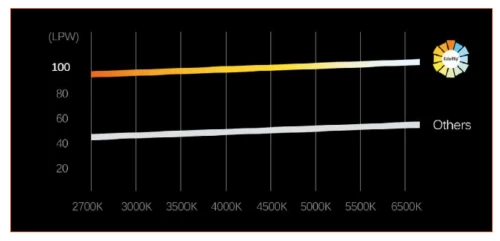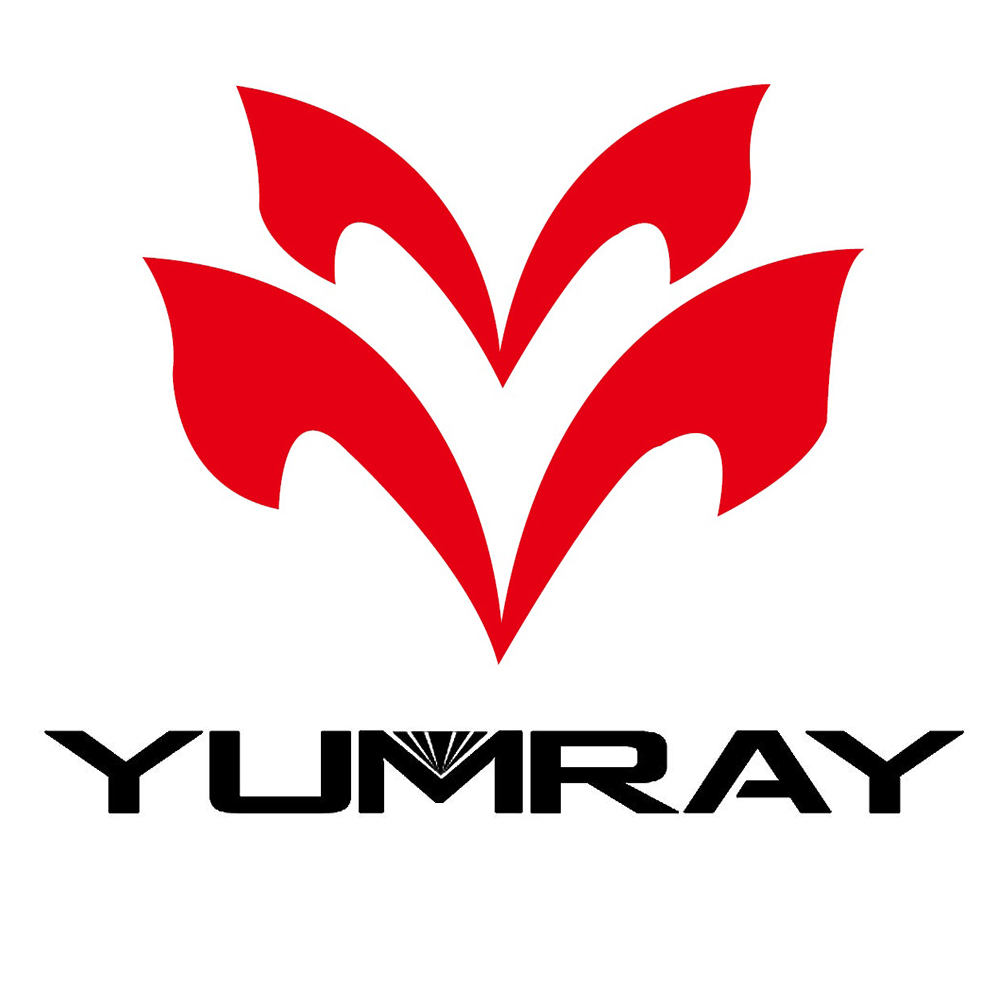LED lighting: A new technology is transforming tunable white light solutions
The problem of traditional adjustable white light source
In traditional LED light sources, surface-mounted leds with separate lenses are scattered over a large circuit board area, with each light source clearly visible. Most adjustable white light solutions combine two sets of leds: one in warm white and one in cold white. White between two color dots can be created by raising and lowering the output of two color leds. Mixing colors at both ends of the CCT range on a 100-watt luminance can result in a loss of up to 50% of the total lumen output of the light source because warm and cool leds are inversely proportional to each other. To get a full output of 100 watts at 2700 K or 6500 K color temperatures, twice as many lamps are required. In traditional tunable white light designs, it provides inconsistent lumen output across the entire CCT range and loses lumen intensity when mixing colors to the two extremes without a complex control mechanism.

Another key element of adjustable white light is the control system. Many times, adjustable white lamps can only be paired with specific drives, which can cause incompatibility issues for retrofitted or existing projects with their own dimming drives. In this case, expensive independent control systems need to be specified for adjustable white light fixtures. Since cost is often the reason for not specifying adjustable white light fixtures, independent control systems make adjustable white light fixtures less feasible. Loss of light intensity during color mixing, poor light source visibility, and expensive control systems in traditional tunable white light solutions are common reasons why tunable white light fixtures are not used more often.
Using the latest flip chip technology
The latest adjustable white light solution uses flip chip CoB LED technology. Flip chip is a direct-mounted LED chip with 70% better heat transfer than conventional SMDS (surface-mounted diodes). It significantly reduces thermal resistance and improves cooling levels, enabling flip leds to fit tightly on a 1.2-inch chip. The goal of the new adjustable white light solution is to reduce the price of LED components without compromising performance and quality. Flip chip CoB leds are not only more cost-effective to produce than SMD leds, but their unique packaging provides significant lumens at high wattage. Flip chip CoB technology also provides 30% more lumen output than traditional SMD leds.
The advantage of making leds more focused is that they provide uniform light in all directions.

Having a compact light engine also enables adjustable white light in lamps with smaller apertures. The new technology provides the lowest thermal resistance on the market, with only 0.3K /W junction to the Ts measuring point, thus providing consistent performance and longer service life in higher wattage lamps. Each of these 1.2-inch CoB leds produces 10,000 lumens, the highest lumen output for adjustable white light solutions currently on the market. While other existing adjustable white light products have an efficiency rating of 40-50 lumens per watt, the new adjustable white light solution has an efficiency rating of 105 lumens per watt and a color rendering index of more than 85.

Advantages of new technology
While traditional adjustable white light solutions require an increase in the number of lamps to match the output of monochrome lamps, the new unique design and proprietary control panel provide maximum lumen output during color adjustment. Its ability to maintain up to 10,000 consistent lumen outputs during color mixing from 2700 K to 6500 K is a new advance in the lighting industry. Adjustable white light features are no longer limited to low-wattage commercial Spaces. Large projects with ceiling heights over 80 feet can take advantage of the versatility of multiple color temperatures.
With this new technology, candlelight requirements can be met without doubling the number of lamps. With minimal additional costs, tunable white light solutions are now more feasible than ever. It also allows lighting designers to have complete control over the color temperature even after lighting is installed. Color temperature decisions are no longer needed at the planning stage because with new advances, on-site adjustable CCT becomes possible. There is approximately 20% additional cost per fixture and no CCT limitation for any project. The project owner and lighting designer have the flexibility to adjust the color temperature of the space to suit their needs.
Precision engineering enables smooth and even transitions between color temperatures. LED light imaging will not be used in this technology, which provides better illumination than traditional tunable white light engines.
conclusion
What the new technology brings to the lighting industry can be summarized in three aspects - efficiency, quality and cost. This latest development brings flexibility to the lighting of Spaces, whether in classrooms, hospitals, recreation centers, conference centers or places of worship.
During color mixing from 2700 to 6500K CCT, the light engine provides a consistent output of up to 10,000 lumens. It beats all other adjustable white light solutions at 105lm/W. Specially designed with flip chip technology, it provides better heat dissipation and higher lumen output, consistent performance and longer service life in higher power lamps.

